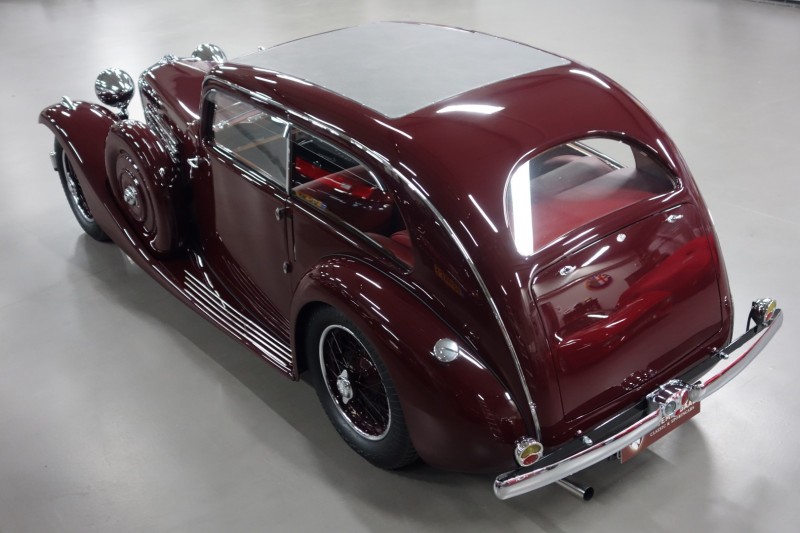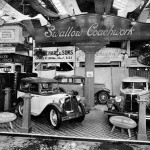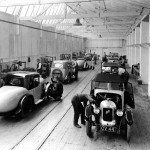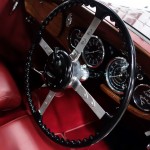
JAGUAR: 100 Years Special | Episode 01 – SS1
Episode 01 – SS1
By Roberto Marrone / Photo credits go to their respective owners
It’s now 100 years since William Lyons, getting a bank credit of 1,000 pounds, founded the Swallow Sidecar Company in Blackpool along with his partner William Walmsley. They started producing elegant aluminum sidecars with great success and a few years later they moved to work on the body of the Austin Seven, then the Morris Cowley and changed their name by adding “Coachbuilding” in it. With the work increasing, space is no longer enough and the company moves to Coventry. In 1929 other innovations were presented at the Motor Show on the mechanics of the Standard Big Nine, the FIAT 509 and the Swift Ten, but it was with the Standard that a fruitful collaboration began. 1930 practically marks the transition to the automotive sector.
Other cars are undergoing improvement such as the large six-cylinder Standard 16 BHP with Enfield chassis. The Swallow brand has existed for nine years now and continues to expand successfully, but Lyons is still not satisfied, because only dealing with other people’s bodywork and chassis limited his ambitions. So he decided to ask Standard Motor Company to build a special chassis for the Swallow on which he would fit the engines of the Standard and in the meantime a skilled PR prepared the launch in style, with slogans like – “Wait, the S.S. is coming, two new coupes of incomparable beauty “and” A car that will kindle the hearts of motor lovers with passion” or even “There is something different, better” – These were the slogans for the 1931 London Motor Show thus arousing expectation and interest.
JAGUAR SS1 (1932-1936)
Indeed, when the SS1 and SS2 coupe were unveiled to the public, they really aroused a lot of interest, the body was very low with the exaggeratedly long and streamlined bonnet, even if in the original design the roof was even lower in order to enhance its line even at the expense of interior habitability. The press said it had the look of a £ 1,000 car, although its price was actually very low, around £ 310 and this was proof of William Lyons’ unique ability to offer products with great value for money. He was obsessed with the idea of building ultra-low-slung cars, pulling back the engine position and mounting the suspension next to it, so as to achieve a streamlined and sporty appearance. Lyons’ ideas were perhaps a little radical for practical purposes, but hey his cars were wonderful. Bedridden from appendicitis, he was absent from the factory in a vital period for the development of the new car. When he came back to work, he found out that what had been built did not coincide with his original design: Walmsley had made the decision to raise the car roof a few inches, to improve visibility and on board comfort. Lyons went on a rampage and the two partners had a furious quarrel. From the comparative drawings you can understand how the car should have been.
Initially, the performance of the SS1 was not up to par with the competition, but the solution soon came with the arrival of Harry Weslake. The SS2 was overshadowed by the success of the SS1, but over time, even this model had its deserved success as far as sales concern. It was not long before the increased 2,552-cc 20 BHP engine was launched and in 1933 modifications were introduced making the model bigger, more manageable and versatile. The wheelbase was also lengthened by seven inches and the roadway widened as well. In the summer of 1933 the Tourer SS1 joined the coupe models. In addition of being the first convertible variant, it took part at an official competition. A team of three Tourers entered the Alpine Trial and the SS name became more and more established thanks to the victory of the team in a particularly tough race. Then the small SS2 got a custom frame, increased the wheelbase by a good 30 cm and undergone modifications to the fenders so to adapt it to the more modern line of its bigger sister. In 1934 the range was further expanded with the arrival of a sedan called “four light”.
During the same period William Walmsley, who did not share the love for cars like his partner, had lost interest in the company and therefore decided to leave. in May 1933 the company changed its name to SS Cars Ltd and in January 1934 it went public as a joint stock company. Lyons assumed the role of President and Executive Director. The name “Jaguar” still does not appear because it will be adopted at the end of the Great War, since SS evoked other meanings.
The SS1 was produced from 1932 to 1936. From the start of production to 1934, the car was equipped with two engines: a 2,054-cc in-line 6-cylinder with side valves delivering 48 horsepower, or a 2,552-cc with 62 horsepower. Later, from 1934 to 1936, new 2,143-cc (53 horsepower) and 2,663-cc (68 horsepower) petrol engines were adopted; the engines were provided by Standard Motor Company.
The car was very popular both for its line and for its low list price. Its top speed was 121 kph (75 mph) and it has been produced in about 4,200 units. Initially it was only available as a 4-seater spider version, but in 1933 the Tourer variant was launched. In 1934 the chassis was modified to have a wider track and front end. The 4-speed manual gearbox was equipped with a synchronizer. In 1935 the Airline coupe was added to the family.














































